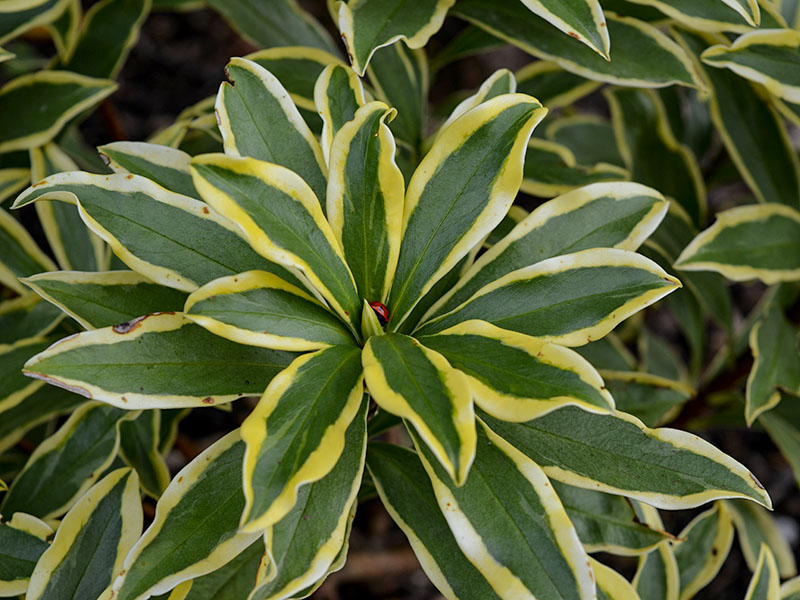| General Description | An evergreen shrub with dark green leaves trimmed in yellow. Clusters of purple-pink flowers bloom in early spring.
|
| ID Characteristic | Winter daphne has clusters of white and purplish star-shaped flowers in late winter. It is multi-stemmed with dark green glossy leaves and a pink border that is very attractive in winter. |
| Shape | Daphne odora takes up to 10 years to mature, becoming round and oval shaped upon maturing. |
| Landscape | Winter Daphne is strictly used as an ornamental plant in the landscape. It has white and purplish fragrant star-shaped flowers and glossy dark green leaves with a pink border. Throughout the winter, the dark green glossy leaves remain, which makes it an attractive winter plant. The flower attracts pollinators such as bees, butterflies, and moths, making it valuable for wildlife as well. It is imperative to plant them with caution if there are animals or children in the yard, as they are highly toxic when eaten or touched. |
| Propagation | Despite being able to grow Daphne odora from seeds, it may take many years for it to mature enough to be planted in a garden. It is therefore most effective to grow these plants from cuttings. Cut Daphne odora wood from the current season's growth that hasn't flowered but has become firm from December to January. Start with a 15 cm branch from an existing healthy shrub, and remove the leaves from the bottom half of the 15 cm cutting. To begin rooting, the bottom half of the plant should be dipped into root hormones. Plant the cuttings in a pot filled with damp rich soil mixed with compost and perlite. A clear plastic bag should be used to cover the cuttings. Keep the cutting lightly watered for the next few months and take it out every few weeks to check for root growth. |
| Cultivation | In spite of its tolerance to the sun, Daphne odora prefers shade or partial shade. Well-drained organic soil with a pH of neutral to slightly acidic that does not require frequent fertilization. Plants that are established can tolerate a degree of dryness, but new cuttings will need regular watering. A warm climate is preferable to a cold climate for this plant. Plants like this work well as borders for gardens because they are slow-growing and have a dense root system that holds garden beds together. Daphne odora is only slightly salt tolerant, so it should be kept away from roads and remain in gardens. |
| Pests | There are no significant pest issues with Daphne odora. The primary disease issue is wilting and browning of the leaves due to improper cultivation. Aphids may, however, be present on rare occasions. Leaves curl up and turn yellow due to aphids sucking sap from under leaves and flower clusters. Water can be sprayed a few times a day for light infestations. Suffocate aphids by spraying soapy water on heavier infestations. |
| Notable Specimens | Missouri Botanical Garden in Missouri, United States of America has some Daphne odora in their collection. |
| Habitat | Wild Winter Daphne grows in China, Vietnam, and Taiwan in moist well-drained acidic soil. It prefers sun to partly shaded areas. |
| Bark/Stem Description | The bark of Winter Daphne is light-brown and beige in colour. Thin dense branches grow from its multi-stemmed structure. |
| Flower/Leaf Bud Description | Daphne odora has rosy-purple buds (2.5 cm in length) that emerge in late winter to early spring before blooming with star-shaped white and purplish flowers. |
| Leaf Description | A whorl of dark green, glossy leaves that is crowded, alternate, coriaceous. Surrounded by a white border. Leaves are 10 cm in length. |
| Flower Description | Rosy purple buds open to white and purplish star-shaped flowers in late winter to early spring. They are extremely fragrant, tubular in shape and have 4 spreading lobes and are 5-8 cm in length. |
| Fruit Description | In July-August, Daphne odora produces burgundy/red fruit around 6 mm long, but cultivated shrubs rarely produce them. |
| Colour Description | The Winter Daphne has rosy-purple buds that emerge in late winter to early spring before blooming with 4-lobed star-shaped white and purple tubular flowers. In summer, it may produce burgundy/red fruit. There are thin multi-stemmed branches with brown/beige bark and glossy dark green leaves with a white border at the edge. During winter and spring, dark green foliage is more prominent, but foliage remains throughout the year. |
| Texture Description | Winter Daphne has a medium texture and does not change throughout the seasons. |
